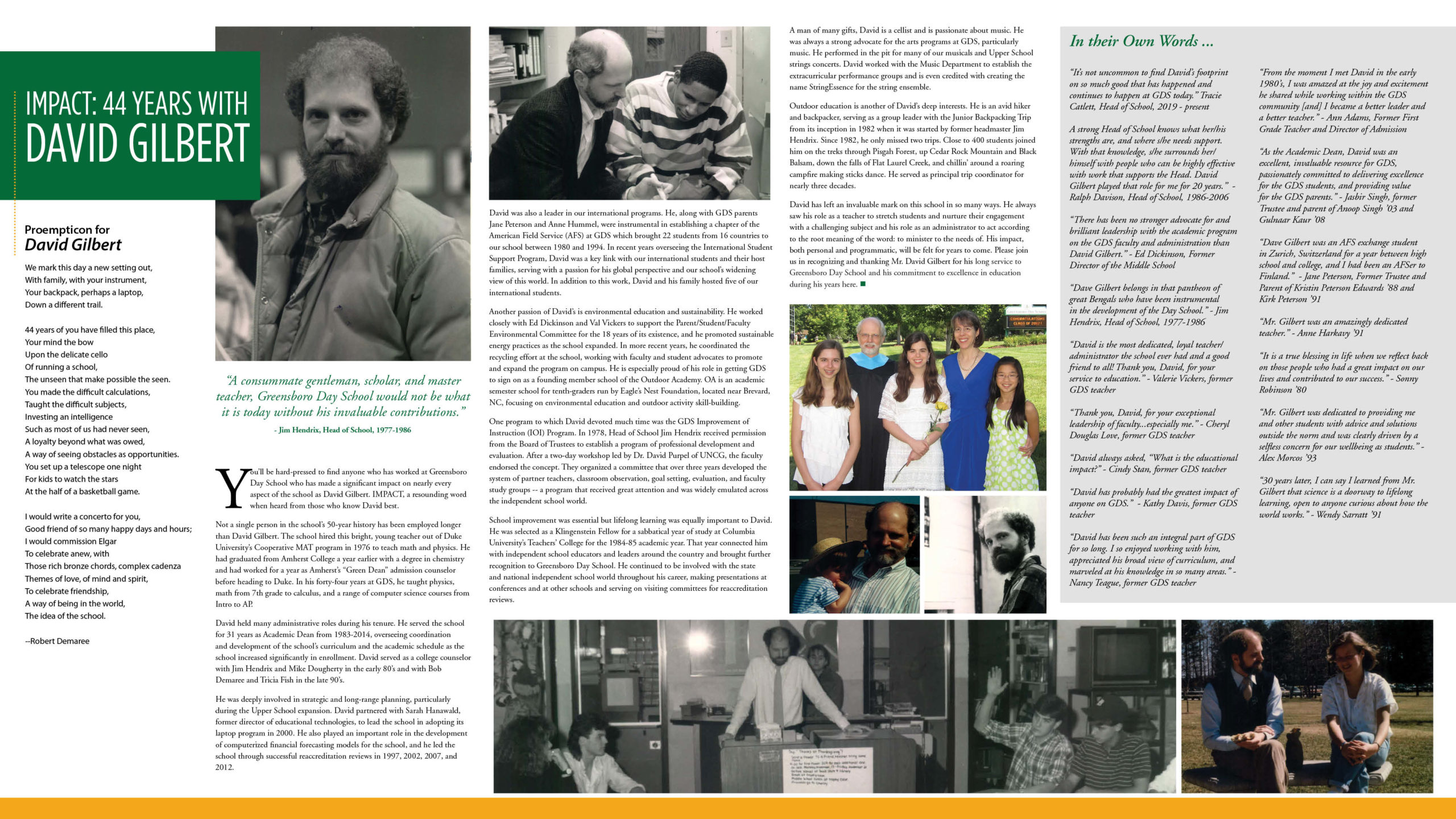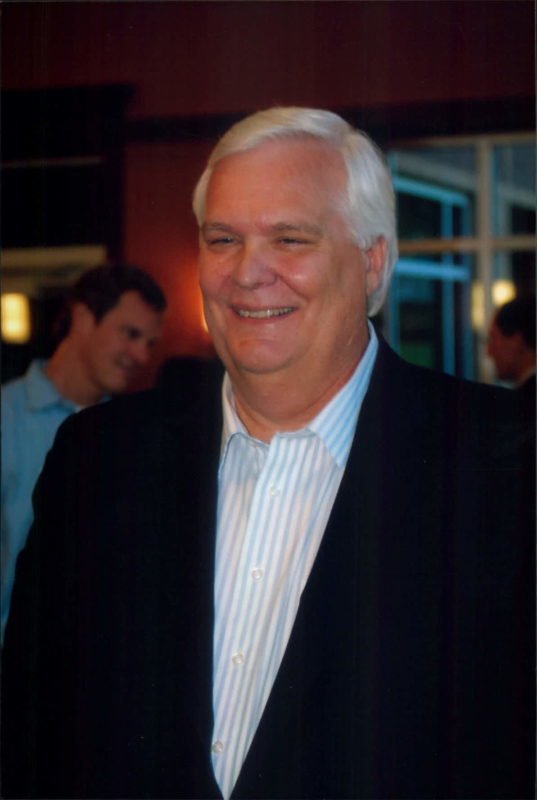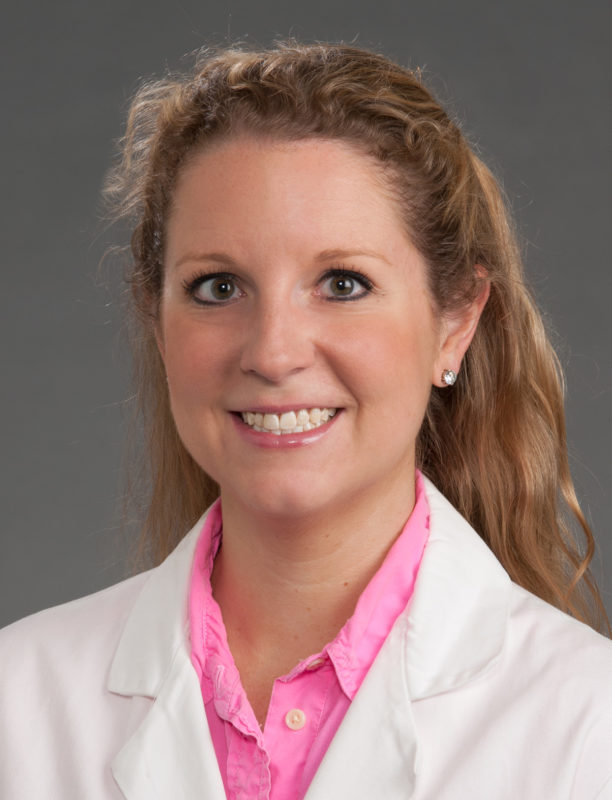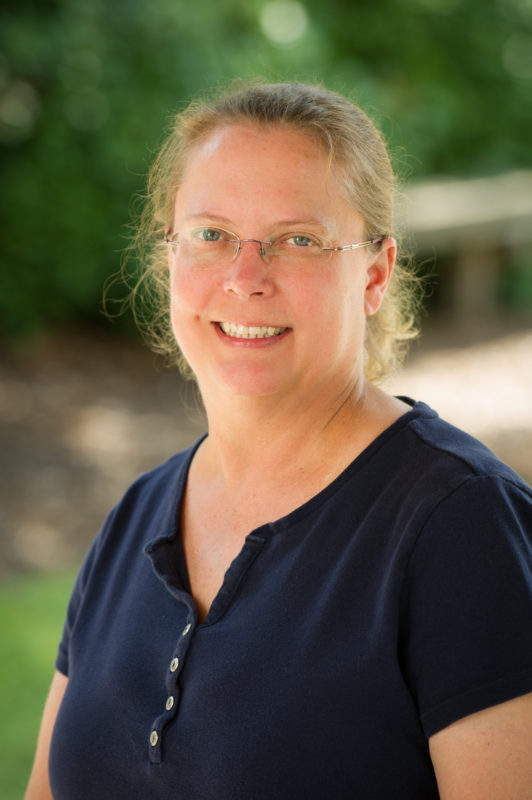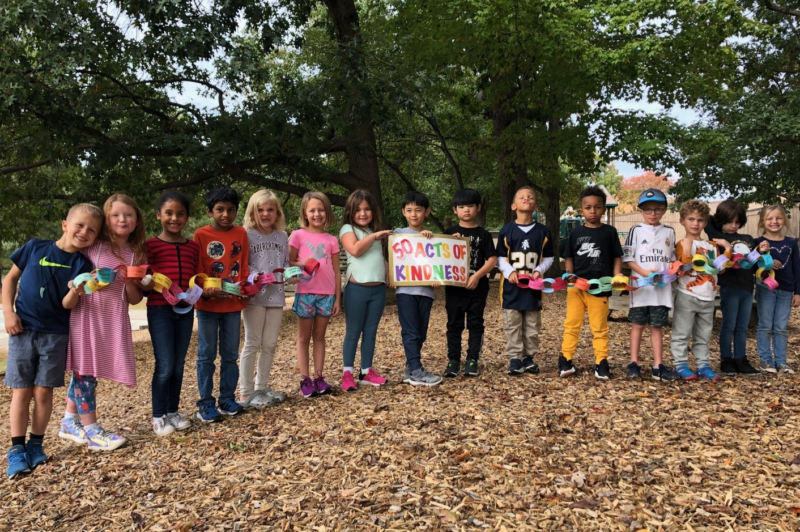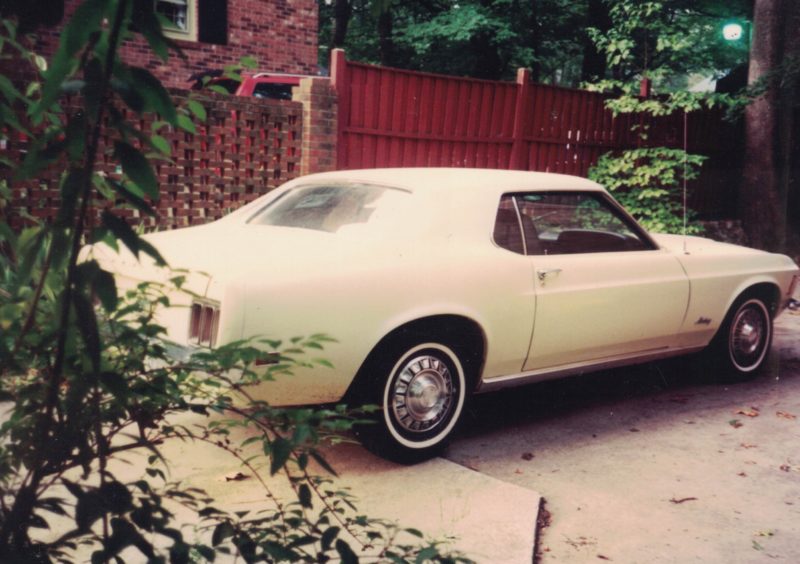Category: Stories
A Man for All Seasons
By Jane Gutsell (originally included in the GDS Magazine in 2014)
Bob Satterfield says that retirement is “the dessert of life.” Having taught at Greensboro Day School since its founding and retiring in June 2007 after 37 years of service as both a teacher and an administrator, Bob has lots of different desserts on his plate. The best thing is being able to set his own schedule and to pursue his many hobbies. First, there’s his love of gardening. Spring is thus his favorite time of year when he can go to flower shows and nurseries and work in his yards both here in Greensboro and at his and his wife Vada’s small cottage on Rockingham Lake, which they share with retired chemistry teacher K Windham. This retreat is very important to this former tobacco farm boy because, as he says, it has brought the sense of country back into his life. After almost eight years of his and K’s landscaping there, the yard is in full bloom now and boasts several abundant blueberry bushes.
Another of Bob’s passions is re-purposing old furniture and other types of things and in collecting. If Bob is anything (and he is many things), he is a collector. Both of his homes are abundantly and lovingly decorated with southern, especially North Carolina pottery, folk and outsider art, and practically anything handmade.
Bob and Vada’s love of travel was on hold after Vada suffered a bad fall. It took five major operations and four years of rehabilitation to get her walking again during which time Bob found himself entering a new profession as a trained home health care provider. Once Vada was able to travel, they have made two big trips. They went with a group to the Canadian Rockies and especially enjoyed touring Buchart Gardens. On an old rock quarry, the gardens are 200 acres of sunken gardens and a wonderful variety of flowers including the highlight, 600,000 roses which were all in bloom the day they visited. Next they went to Australia, where they were fascinated by the aboriginal people, New Zealand, and three magical nights on Fiji. Their favorite moment was air-ballooning across the Australian Outback at sunrise. As the balloon was taking off it brushed through a patch of a spicy plant, whose fragrance floated right up with them.
Another highlight of Bob’s retirement was the addition last April of a beloved grandson, Cash, who lives in Asheville with mom Christy and dad Jeremy Satterfield. Proud grandparents get to visit once a month or so. As Bob says, “Retirement also brings the excitement of a new tooth!” He is also very proud of his older son Derick, who lives in Reidsville and is the Director of Enrollment for Rockingham Community College. Derick is currently finishing his doctorate in Community College Leadership.
Bob and Vada enjoy monthly lunches with other GDS retirees, continuing the Day School tradition of camaraderie, a strong feeling that made working there so wonderful. To all of students and school friends, he says, “I can’t tell you what it meant to have such a supportive, warm place to work. It was the best experience. My thanks to all.”
Remember Mr. Satt
by Kathy Davis (spoken at his funeral)
Bob, Bobbo, Mr. Satterfield, Mr. Satt, husband, dad, papa, friend, teacher, mentor and so much more. Those are a few of the names we called Bob Satterfield. In fact, we call him a legend because Bob was larger than life – a man who loved us all. Bob and I were math teachers so it’s only right to do a word problem involving statistical analysis. I’m going to estimate that everyone in this room has at least 5 Bob stories. And, for those who have known him for years, I estimate 500 Bob stories. Given that each of those stories would take at least 2 minutes, I’m estimating that it would take us at least 3000 hours to collectively share Bob stories. Just so you will know that is at least 4 months around the clock to tell Bob stories. That was Bob. So many stories. So much love. So much care. So many laughs. So much fun. I’m sorry that we don’t have 4 months to hear Bob stories. But, I hope we will continue to tell Bob stories for the next 40 years. I am grateful to Vada, Derick, Jeremy and Christy for allowing me to tell a few of my Bob stories.
In the spring of 1974, I went to Greensboro Day School as a student teacher. I was told that there was a new school with a young teacher who wanted a student teacher. That’s how I met Bob Satterfield. He was the young teacher. Little did I know what was in store for me. I drove out to the little school in the country to meet Bob. There he was, tall with long DARK hair and he immediately made me feel part of the crowd, just as he did with everyone he met. I had a great time for those weeks and went from a kid who thought she would do statistics and make a lot of money to a young woman who loved teaching and realized money was not the goal. All because of Bob. He changed my life. At the end of my student teaching, GDS offered me a job and Bob negotiated my contract. I had graduated and was living with my mom in eastern NC when Bob called with the offer. He said the salary was $7000 and I said I didn’t know if I could live off of that, so he called back the next night with his new negotiated offer. He was so excited to offer $7100. I told my mom and she said, “Obviously you have made a great friend. That’s more important than any money. Take the job and enjoy it.” So I did and I never regretted that decision and Bob was one of the main reasons.
For about 20 years, Bob and I ran the “Orange Drive” at the school. We were voluntold and we could never give it up. In the beginning, we used the church across the street to distribute the citrus. We would go over with about 15 students, some borrowed rollers from Food Lion in 20 degree weather and unload an 18 wheeler that was packed with oranges and grapefruit. Every year, as we stood there and the truck driver opened the full truck, Bob would always say, “Hum, Mrs. Davis, it looks like we have a few oranges.” From there, all you know what would break loose, and we would work for 2 days as hard as we could to get rid of those oranges. As the drive grew, we eventually moved from the church to a larger warehouse. We would order extra oranges so that Bob could sell them to the warehouse employees at cost. He was amazing. He talked to everyone, sold them citrus and made them feel like a million dollars. He saw value in each person.
Bob had the best “people skills” of anyone I’ve ever met. He could make a friend out of a snake. I’ve seen him in many situations. He could walk up to a dignitary and make conversation or he could meet someone with no education and make them feel comfortable. I have seen him handle irate parents who just knew the school had done their child wrong in such a way, that by the end, they were hugging Bob and thanking him. He had a calm way that brings “someone to their knees.” I often sat in awe as Bob talked to a student. I’ve seen him work with teachers to make them better. Again, he saw the best in every person. He knew that everyone can and will make a mistake but that there is mostly good inside that person. He managed to bring out that good in all of us.
When asked what he taught, Bob epitomizes the phrase “I teach children.” He used math as the vehicle to teach those children, but he loved and taught the child. He was a master teacher and could explain concepts better than most. Bob made every student feel they could be successful. I’ve seen him take the most math phobic child and make them feel like they were the math star. Bob had the patience of Job. He wanted the best for his students. He was a recipient of the James P Hendrix teaching award, the highest award given to a GDS teacher. I remember the day he got the award. He said, “I think this has little to do with teaching the quadratic formula and a lot to do with working with children.” He was right.
I would estimate Bob chaperoned over 100 dances in his 37 years at GDS. I know you find this hard to believe but dance time is a time in which a student could possibly make a bad decision. Bob was in charge of discipline. At a dance, he would look around and he would identify the problem, and would walk over to me and say, “Mrs. Davis, may I speak with you a moment.” I knew that was the kiss of death and that I would be with Bob when he spoke with the student. He was a master. Of course, the student would always deny the problem initially but after a little Mr. Satterfield conversation, they would own up to it. Bob always assured them that while they had made a mistake, we still loved them and would work with them.
I’ve talked a lot about Bob as a teacher and administrator but then there was Bob as a friend. My mother decorated my house every Christmas until her death in 1991. Bob knew I was dreading the first Christmas after her death. One day my doorbell rang and there was Bob with enough greenery to fill up the coliseum. Since 1991, Bob decorated my house every Christmas. We would take a whole day to talk and laugh and eat and decorate. It was such a wonderful gift from him. Ironically, we had named December 16th as our decorating day this year. The day he passed away.
I sound like I was the only recipient of Bob’s generosity but I am not. Like the time, our friends Judy and Ed were getting married in Vegas and Bob pulled Judy aside to say he and Vada would like to go witness this occasion. What a gift. Or the time, Bob went out to help our friend when her husband passed away. Bob as a friend was one of a kind. I can’t tell you how many of us were recipients of small gifts he saw and knew it would bring a smile. He always put others first. Bob made every friend feel like his best friend. There is a brick on the quad at GDS that says the names of four of us who were known as the four musketeers. Tricia Fish, Cindy Stan, Bob’s and my names around the words “friends forever.” After Bob’s death, I put a picture of the brick on fb and said, “Well, this sums it up.” So many wonderful students responded. My daughter responded by saying some people never know the type of friendship the four of us share. She’s right. We are truly blessed. But let me make sure you understand there could be 100 names on that brick, and possibly a 1000. The turnout here today speaks to the number of people who loved Bob.
When Bob was diagnosed with AML, I thought he will beat it. But, I came to realize many people diagnosed with this horrific disease live less than a week. We had four weeks. I got to visit Bob and on one of those visits he was very alert. Our friend Judy fed him a tangerine. He felt better and asked me to order him a cup of coffee. Of course, he took charge and told me just how to order the coffee. We got to say we loved each other. He asked me to pray and I did. It was a visit I will never forget. The love in that room was so much bigger than life and Judy and I are so thankful for that time with Bob.
When Bob retired, we had the biggest retirement party that has ever been given at Greensboro Day School, including math teachers dancing and singing to Dolly’s 9-5 to honor Bob’s love of Miss Dolly and his Dolly trash can which is infamous. But the truly famous person wasn’t Dolly – it was Bob. At the end of that retirement party, Vada suggested we play the song from Wicked “For Good.” It was a perfect song. This is when I wish I could sing but that my voice would not honor Mr. Satt. But I do want us to think about the words. Bob, here’s to you. Like the song says, “So much of me is made of what I learned from you. You’ll be with me like a handprint on my heart. I do believe I have been changed for the better because I knew you. I have been changed for good.”
I want to go one step further. Bob, we believe we have been changed for the better because we knew you. We have been changed for good. Thank you, Bob, thank you. Godspeed.
Written by Valerie Vickers, 1982-2007
For me, science teaching and learning are best explored experientially. This philosophy was the cornerstone of my teaching over 25 years in the Middle School. My classes were multi-faceted with hands-on experiments, science projects and outdoor experiences that involved nature trails, butterfly and permaculture gardens. Eventually technology played a large role as we compared rainfall studies in different parts of the US and did biodiversity studies on our own campus, including building our own GIS map. Community service like the Winter Walk for AIDS, building a structure for children with special needs at a nearby park and cross-curricular units such as our 7th Grade Population Unit brought the larger community into our classroom. Working with Guilford Soil and Water Conservation gave students the opportunity to hone skills in public speaking, art, and cooperative learning on Envirothon teams. I hope students remember the recycling programs and problem-solving we did as we proposed more sustainable solutions on our own campus. Our field trips to Umstead State Park, Morrow Mountain State Park, Camp Broadstone, Campbell’s Folk School and Green River Preserve are hopefully high points for many students who remember 6th and 7th Grade Science. These special experiences happened because of wonderful colleagues and a supportive administration.
Within the faculty, I was one of the catalysts for bringing a more sustainable vision to our school. The Student/Parent/Faculty Environmental Committee was established in 1989 and continued until 2007. Once a month, representatives from each division met to share ideas for making our campus more “green.” Gardens, ponds and wild spaces were cultivated so that students could interact with nature. Ultimately, the Natural Learning Pond with boardwalks and an outbuilding were created with the help of NC State and NC A&T. In addition, I also navigated a PhD program (supported financially in part by GDS) in Foundations of Education that culminated in a dissertation, Exploring Ecological Identity: Education to Restore the Human/Earth Relationship. I became involved in Greensboro Beautiful and the Advisory Committee for Sustainability for Greensboro. I was fortunate to receive the Thomas Berry Award from the Greensboro Public Library in 2011 for my work.
Finally, I am also a parent of a son Hansen Grider who graduated in 2000. I am so appreciative of all his teachers, coaches and mentors who helped him grow in knowledge and wisdom for his future endeavors over the five years he attended GDS.
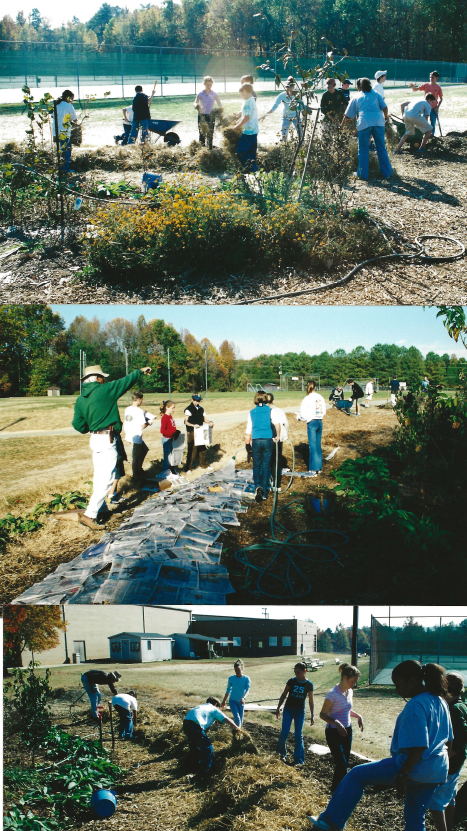
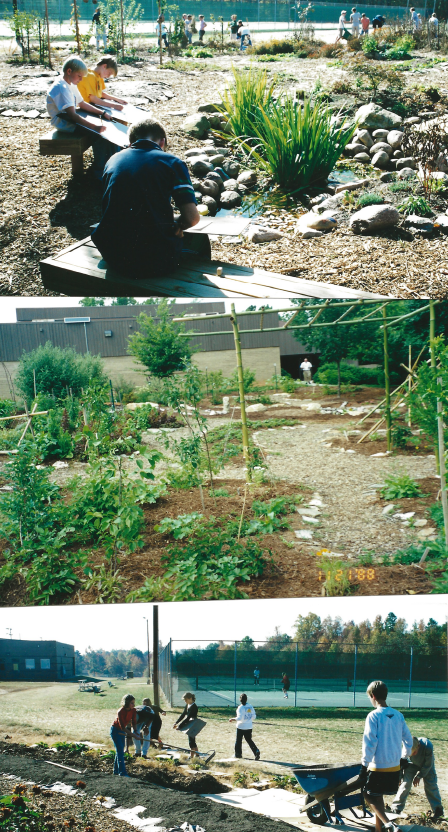
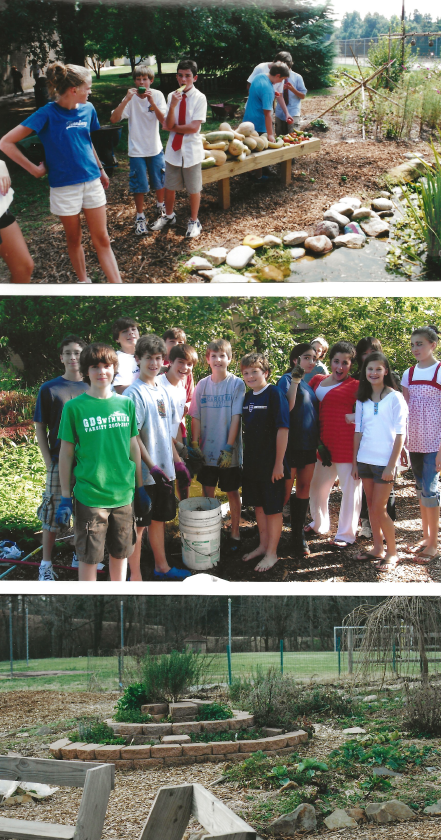
At GDS:
Junior Thespian
Honor Society
Headmaster’s List
Honor Board member
Thespian Award
Best Female Vocalist
Cum Laude
After GDS:
BS from Wake Forest University, 2004
Kappa Delta, Zeta Omicron Chapter President
Productions with Little Theatre in Winston Salem (Peter Pan, Chorus Line)
Master in Medical Science Wake Forest School of Medicine
PA degree from Wake Forest School of Medicine, 2010
James Franklin Wilson award, WF School of Medicine
NC Academy of PAs 2018, President
Avid Triathlete and Half-Marathoner
Most would remember Samantha’s time on the GDS stage, starting in middle school and growing in upper school to involvement in virtually every production as a lead character. That passion and love continued after graduation and included several musical productions at the Winston Salem Little Theatre including Peter Pan (role of Wendy), and Chorus Line (role of Judy.) It also included a small yet powerful production of Quilters at SECA. While not on the stage as of late, Samantha has pursued a career in Medicine at Wake Forest and has been a practicing PA in Internal Medicine, Section on Gerontology for the past 9 years. In that role she provides primary care for patients with all geriatric syndromes and has a very integral role in the Alzheimer’s Research Center. She has developed an expertise in the care of patients with dementia of all types and severity. In her spare time, she has led PAs at the state level, holding various leadership positions on the North Carolina Academy of PAs Board of Directors for the past 7 years including a recent 3 year Presidential term. Advocacy for the PA profession and patients is very important to her and has been a tremendous outlet for leadership growth and influence. When not engaged in professional ventures, Samantha loves working on her Triathlete goals and quest for the Half Ironman!
Written by Madame/Señora Kerensa Wooten
It has been a real struggle for me to decide what to include in a snapshot of wonderful memories about having had the true honor of teaching, learning, and working with such excellent students, families, faculty, staff, and friends at GDS. After many drafts of attempts, I have decided primarily to say thank you to all for the twenty years that I was gifted to work in the school teaching French and Spanish to 4th through 12th graders. As a retiree, I am beginning to discover the magnificent joys of such instances as having a parent say that while I did not teach her eldest child, she was happy to know that I was at the school looking after that student. Another moment I cherish is when an alumnus thanked me for a trip to Chile while he was passing through a foyer-full of current and past teachers and administrators on his way out of an alumni function. I especially enjoy moments when former students and current alumni are actually delighted to see me after one of their performances in a local theater, on campus, or in a grocery store, for they may not have been when they had to suffer through endless verb conjugations, the introduction to the subjunctive mood, or my stubborn insistence that they treat each other as human beings! iGracias a todos et merci beaucoup!
On Monday, August 19th, former teachers Mr. Bob Satterfield, Mrs. Nancy Teague and Mr. Carl Fenske visited campus to share their memories from GDS with our current faculty and staff. We wanted you to hear these stories as well!
Written by Dr. Jane Gutsell, Upper School English Department, 1987 – 2012
In the fall of 1987, coming from a college teaching background, I naively assumed that teaching high school seniors would not be appreciatively different from college freshmen. My first seniors and I can look back and laugh now, but that first year was a little rough for all of us. The willingness of the school’s administration, Ralph Davison and Bob Demaree most importantly, to give me time to find my way and the freedom to make my own way meant everything. It took a couple of years, but by then I was all in! Greensboro Day School was the best thing that could have happened to me. And – teaching high school students for 24 years was and continues to be profoundly rewarding. I love hearing from so many of my former students and, best of all, seeing them at alumni events, such as the big one coming up in May to celebrate our school’s 50th Anniversary.
Some of my favorite memories have to do with the personal, not to say idiosyncratic, touches I added to my regular syllabus. My second year I initiated the Yule Tree tradition, honoring the ancient European practice of celebrating the Winter Solstice. Right before December exams I set aside a day for a party to decorate the tree with ornaments depicting characters or scenes from the literature we had studied that semester. Most popular were Beowulf, The Canterbury Tales and Hamlet, Grendel’s bloody arm and the dragon frequently graced the tree top! Over the years my bulletin boards became archaeological sites of saved ornaments, postcards, literary cartoons, and all kinds of memorabilia.
In the spring, studying the Romantic poets, each section of AP Lit would use colored chalk to draw artistic illustrations of Coleridge’s mysterious and haunting “Kubla Khan.” Their pictorial depictions were very competitive with lots of clever and funny visual puns and double meanings. Even the students who claimed to have no artistic talent contributed good ideas.
Also early on, having learned that seniors need extra R&R after college acceptances started rolling in, I established “Kindergarten Day,” when we could all regress to our kid-selves. Students could come to class in “jammies” and bring stuffed animals or “blankies”. Sitting on the floor, they happily nibbled on Vanilla wafers, sipped from cartons of apple juice, and watched episodes of “The Muppet Show.”
At the front of my classroom stood a long table with tea cups, a variety of teas, and an electric kettle so that anyone wanting a nice, hot cup of tea before class began could have one. My room had a sofa and some chairs, some years a futon or two, and even a few old-fashioned bean bag chairs. Scattered about were my beloved stuffed animals – Benjy the Bengal Tiger, Roscoe the Gorilla, Molly the Moose, and many more. I loved my classroom. An ADHD kid’s nightmare I admit, but it was warm and cozy and relaxed – a virtually technology-free zone as well, where I hoped most of my students would feel unstressed and at home.
In 1999 a new challenge came my way in the form of sophomores, an age group with which I had absolutely no experience. I wasn’t at all sure that I could even relate to them or adjust my teaching style to their needs. But I needed something new so I thought English 10 Advanced was worth a shot. And what fun those students were! It was a wonderful growing experience for them and for me. I was able to try out new approaches to studying literature and could introduce completely different types of assessments. Their biggest project was a full-length, formal research paper on environmental issues such as endangered species or air or water pollution. In addition to the paper, students had to make oral presentation of their findings. One young woman who had written on the degradation of the Amazon rain forest came to class dressed as a tree! We hated saying goodbye at the end of the year, but then a year later as seniors they would come bursting into my room singing “Together again”! Good times.
For many years Pat Horvath, Upper School Registrar, and I coordinated Senior Projects, one of the Day School’s most significant and successful programs. During those years, my favorite activity was going to see my senior advisees on-site at their individual projects. They were involved in such a great variety of experiences, from medical and legal to architecture and civil engineering to theater and art and so much more. Some seniors were approved for out-of-town projects and some even as far away as New York City and Panama. One year, while I was visiting my daughter at Columbia University, I actually did an on-site visit to the art gallery project in NYC. I have always considered this experiential education opportunity to be one of the most important benefits of being a Bengal!
Wonderful memories too of co-coaching our High I. Q. and Quiz Bowl teams. It was fun traveling to competitions in Raleigh, Chapel Hill, and at Duke, even as far as South Carolina. In 1994 and 2009 the teams brought home the coveted High I.Q. Championship trophy. What a treat to work with such enormously bright and talented young people!
Talk about talent – I was fortunate in teaching the Creative Writing class for several years and in adding an Introduction to Philosophy elective to the department’s offering. Both of those relaxed workshop-style classes gave me an opportunity to experiment with non-traditional teaching methods. Yet another example of the freedom we teachers and our students enjoyed.
Among my favorite and most challenging experiences was working with Linda Sloan and Ruthie Tutterow as the dramaturg/assistant director on many of our spring plays. I am proud to say that I talked Linda into undertaking her first ever Shakespeare play – the hilarious and transcendent A Midsummer Night’s Dream. After the success of that production, she and later Ruthie went on to Twelfth Night, The Tempest, Romeo and Juliet, The Taming of the Shrew, and the grand finale my last year before retiring, a Las Vegas version of A Comedy of Errors. What a trip! Some of the other productions I was gratified to help with were The Importance of Being Earnest, Tartuffe, The Cherry Orchard (Ruthie and I agree one of the most challenging of all), and a personal favorite Pride and Prejudice. The incredible talent of these young actors never ceased to amaze me. Being an integral part of GDS’ drama program was definitely one of the highlights of my life at GDS.
The freedom to design my own curriculum within the overall expectations of the English Department’s program and particularly with regard to AP Literature and Composition was paramount to me. I could teach the literary works I loved and create assessments that suited my writing and critical thinking goals – never anyone else’s. My AP syllabus included works such as Gilgamesh, the oldest extant literary text in the world, and The Master and Margarita, a strange satire on Stalinist Russia – both very unusual readings for high school English classes, but my students loved them.
When it came to technology, I was decidedly old school. My students were never allowed to use their laptops in class, and for a number of years they were required to write with FOUNTAIN PENS! Many of the students from those years remind me of their fountain pens with great fondness. They felt special. They were special. One of my young women even passed her pen down to her younger brother when he became a senior.
The freedom to be creative reached its height when the department instigated a program allowing a very select group of ninth-graders to enroll as sophomores in AP Language and Composition, which then placed them in AP Lit as juniors. The issue then became what this group of students would take as their fourth Upper School English requirement for graduation. That honor fell to me – and what an honor it was. I created a year-long study of the British Victorian period, my favorite academic field. What a joy! The seminar-style course had a very demanding syllabus but also the fun of tea parties with scones and cucumber sandwiches and students learning to write thank you notes using dip pens and ink wells in flowery, 19th Century style. My “Victorians,” as they liked to call themselves, dove enthusiastically into challenging works by such masters as Dickens, Tennyson, and Browning, but also important but seldom read authors such as Christina Rossetti and William Morris. We studied art and social culture and theater and philosophy. We watched movies set in this period and went on a field trip to the UNCG Rare Book room. It was as broad and as rewarding a course as I had ever been able to offer in any academic setting.
If one were to ask my students about their favorite memories of my classes, I feel sure that many would say, “Northern Exposure”! I decided sometime around the turn of the century (how strange that sounds) to incorporate this award-winning television series as an example of contemporary culture. “Northern Exposure,” heavily influenced by Joseph Campbell and especially Karl Jung, was deeply mythic and philosophical, full of literary references. Each episode usually contained three separate story lines. I would show a particular episode because its theme related to a reading we had just finished but without revealing its relevance. As homework, my students had to write an essay identifying the central theme uniting all subplots and the connection to the literary work and email it to me by the following day. Some of the responses were brilliant! I wish I had kept them all. My students loved the characters and the universal themes – and the challenge of analyzing a TV show, of all things! Again, the Day School’s educational culture of trusting in its faculty to make good choices and create significant learning experiences made it possible for me to follow my occasionally oddball pedagogical instincts and preferences.
No stroll down memory lane would be complete without acknowledging the spirit of collegiality and friendship I found when I arrived that life-changing fall of 1987. The atmosphere of cooperation and support and sharing was unlike anything I had ever experienced in my previous educational environments. Many of those friendships are with me today and even cross divisional lines. These wonderful men and women have celebrated with me when times were good and been there for me when they weren’t. We should all be so fortunate. They are the best! Thanks, GDS, for so many special memories.
Commemorating our 50th Anniversary, Mrs. Saake’s first graders set the goal of recognizing fifty acts of kindness in their classroom by November 1st—the 50th day of school. Whenever a student noticed a classmate doing something kind, they reported that act to their teacher and another link was added to their paper chain. The class was thrilled when their goal was met in just four weeks! They were so inspired that they have opted to keep going and reach a goal of 100 by the 100th day of school.
Written by Mrs. Nancy Teague
Dr. Larry Sorohan was my advisor in the School of Education at UNCG and he encouraged me to apply at this new school that was being opened in Greensboro for which he was on the Board of Directors. I admired him greatly so I did what he suggested, and the rest is history, as they say. I was hired to be the 2nd grade teacher for the opening year of the school in 1970, my first teaching job. While the school was being built on the north side of town on Lawndale Drive, it wasn’t completed, so we spent that first semester at Temple Emanuel. I had 7 students – 5 boys and 2 girls. Ted Welles, who was the first Headmaster, let me know that we had to increase enrollment or they couldn’t afford me (or any of the other teachers for that matter) even though my salary was somewhere in the range of $7,000 for the year! (That obviously went further then than it would now!)
My now infamous story from that first year is this: We didn’t have a library at Temple Emanuel but were only a few blocks from the Greensboro Public Library’s main branch downtown. I knew the value of kids choosing books for themselves to read so I piled all 7 kids (5 in the back seat and 2 in the front passenger bucket seat) into my new 1970 Mustang, and drove them downtown to the library. Will Griswold ’81 tells me that they fought over who got to ride in the front next to the gear shift because I would let them change it. Can you imagine doing such a thing these days? There certainly weren’t enough seat belts for everyone!
The second year of the school I had 15 second graders in the new building on Lawndale Drive. I particularly remember Jo Ellen Stewart, the experienced 1st grade teacher, who was so very helpful to this still new teacher. I also remember working hard to keep these kids challenged and engaged. I didn’t return to GDS the following year, choosing instead to finish my master’s degree at UNCG, and then continued my teaching career in Alamance County Schools.
In 1976, Tommy and I married and I became the step-mom to three GDS students, Lee, Heather, and Jason. Then we added our David to the mix and he entered kindergarten the year after Lee graduated. Jim Hendrix called Tommy a “recycled Dad.” When David was in 1st grade, Sue Mengert offered me a job as assistant to their new conceptual math program, DMP, for 10 hours a week, $100/week. I hadn’t planned to go back to teaching, but realized that I needed to get back to working with kids which I loved to do. Jim Hendrix said that obviously I wasn’t doing this for the money!
Over the years of being in classrooms with the master teachers at GDS and being immersed in the math program, I had a unique perspective on the total program, K-6. My role as an assistant morphed into the role that I kept for many years, that of Lower School Math Specialist (which also included working with 6th grade in the Middle School). It was the best of teaching jobs! And it led to being involved in the math education world outside Greensboro Day School. In the early 1990’s, 6th grade math teacher Carol Williams and I were chosen to participate in a statewide professional development project called Teaching Excellence and Mathematics (TEAM), which led to our doing workshops with K-8 teachers all over the state. We started a yearly math retreat that we called NCAIS TEAM for teachers in independent schools across North Carolina. We did presentations around curriculum and instruction that focused on students learning to understand the mathematics and not just memorizing facts and procedures. Greensboro Day School became known for its effective, progressive math program.
At the end of the 2012-2013 school year, it was time to retire. But Greensboro Day School is not a place that you can easily leave. I’m still involved with some consulting with teachers around the math program, have done some workshops with LS teachers, and am doing some curriculum writing for the Lower School to keep the power of the math teaching alive as the school grows and changes. Greensboro Day School has been a major part of my life and will always hold a special place in my heart.
At GDS:
National Honor Society
Math Club
Chemistry Club
Yearbook Editor
Cross Country
After GDS:
UNC Morehead Scholar
BS in Chemistry, UNC
MD, Duke University (Fullerton Scholarship)
Chief Resident, Vanderbilt University
Researched infectious diseases in Rwanda
Father of 3 daughters
Andy Alspaugh was a member of the first class at Greensboro Day School to complete the 1st through 12th grades. He has always embodied all three aspects of the school’s motto: Friendship, Scholarship, Sportsmanship. He has worked for Duke Medical School since 1996, combining clinical care with research and education in microbiology and infectious diseases. Andy has received numerous scholarships and awards for his work and research in infectious disease, has published research in numerous medical journals and textbooks, and served on the editorial board for three medical journals. He is a professor of the departments of medicine, molecular genetics, and microbiology at Duke. His specialties in infectious diseases has led to a career working with those with compromised immune systems, especially those with HIV/AIDS.

